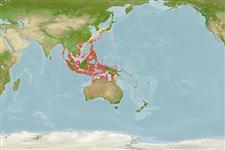Common names from other countries
>
Ovalentaria/misc (Various families in series Ovalentaria) >
Pomacentridae (Damselfishes) > Pomacentrinae
Etymology: Amphiprion: Greek, amphi = on both sides + Greek, prion, -onos = saw (Ref. 45335).
More on author: Cuvier.
Environment: milieu / climate zone / depth range / distribution range
นิเวศวิทยา
เกี่ยวกับทะเล,น้ำเค็ม เกี่ยวกับหินโสโครก; ไม่มีการอพยพย้ายถิ่น; ระดับความลึก 1 - 15 m (Ref. 7247), usually 3 - 15 m (Ref. 55267). Tropical; 46°N - 17°S, 92°E - 147°E (Ref. 55267)
Indo-West Pacific: eastern Indian Ocean including Andaman and Nicobar Islands, Thailand, Malaysia, and northwest Australia to Singapore, Indonesia, and the Philippines; ranges north to Taiwan and the Ryukyu Islands.
ขนาด / น้ำหนัก / Age
Maturity: Lm ? range ? - ? cm
Max length : 11.0 cm TL เพศผู้/กระเทย; (Ref. 9710)
Short description
เครื่องมือที่ใช้ในการแยกชนิดสัตว์,สิ่งมีชีวิตออกจากกัน | สัณฐานวิทยา | ความยาวต่างๆ
เงี่ยงครีบหลัง (รวม) : 10 - 11; ก้านครีบอ่อนที่หาง (รวม) : 13 - 17; เงี่ยงครีบก้น: 2; ก้านครีบอ่อนที่ก้น: 11 - 13.
Adults inhabit coral reefs where it lives among the venomous tentacles of large sea anemones (Ref. 85309). Occur in shallow and calm lagoons. Are protandrous hermaphrodites (Ref. 32167). Distinct pair is monogamous (Ref. 32167). Oviparous, distinct pairing during breeding (Ref. 205). Eggs are demersal and adhere to the substrate (Ref. 205). Males guard and aerate the eggs (Ref. 205). One of the most popular marine aquarium fishes. Bred artificially in Florida for the aquarium trade. Associated with the anemones: Heteractis magnifica, Stichodactyla gigantea, and Stichodactyla mertensii (Ref. 5911). Has been reared in captivity (Ref. 35410, 35413, 35415, 35418, 35420). Has reached an age of 12 years in captivity (Alexandre Fontayne, pers. comm., 2006).
Life cycle and mating behavior
Maturities | การสืบพันธุ์ | Spawnings | Egg(s) | Fecundities | ตัวอ่อน
Benthic spawner. Length at sex change = 4.4 cm TL (Ref. 55367). Oviparous, distinct pairing during breeding (Ref. 205). Eggs are demersal and adhere to the substrate (Ref. 205). Males guard and aerate the eggs (Ref. 205). Also Refs. 240, 7471, 118437.
Allen, G.R., 1991. Damselfishes of the world. Mergus Publishers, Melle, Germany. 271 p. (Ref. 7247)
IUCN Red List Status (Ref. 130435)
CITES (Ref. 128078)
Not Evaluated
Threat to humans
Harmless
Human uses
การประมง: ไม่มีผลประโยชน์; สถานที่แสดงสัตว์และพืชน้ำ: การค้า
เครื่องมือ
Special reports
Download XML
แหล่งที่มาจากอินเตอร์เน็ต
Estimates based on models
Preferred temperature (Ref.
115969): 26.2 - 29.3, mean 28.7 (based on 1746 cells).
Phylogenetic diversity index (Ref.
82804): PD
50 = 0.5000 [Uniqueness, from 0.5 = low to 2.0 = high].
Bayesian length-weight: a=0.01479 (0.00642 - 0.03409), b=3.00 (2.80 - 3.20), in cm Total Length, based on LWR estimates for this (Sub)family-body shape (Ref.
93245).
ระดับชั้นอาหาร (Ref.
69278): 3.1 ±0.36 se; based on food items.
ความสามารถในการกลับคืนสู่ปกติ (Ref.
120179): ความสูง, เวลาต่ำสุดที่จะทำให้ประชากรเพิ่มขึ้นเป็น 2 เท่าใช้เวลาน้อยกว่า 15 เดือน (tm<1; Fec=600).
Fishing Vulnerability (Ref.
59153): Low vulnerability (10 of 100).
